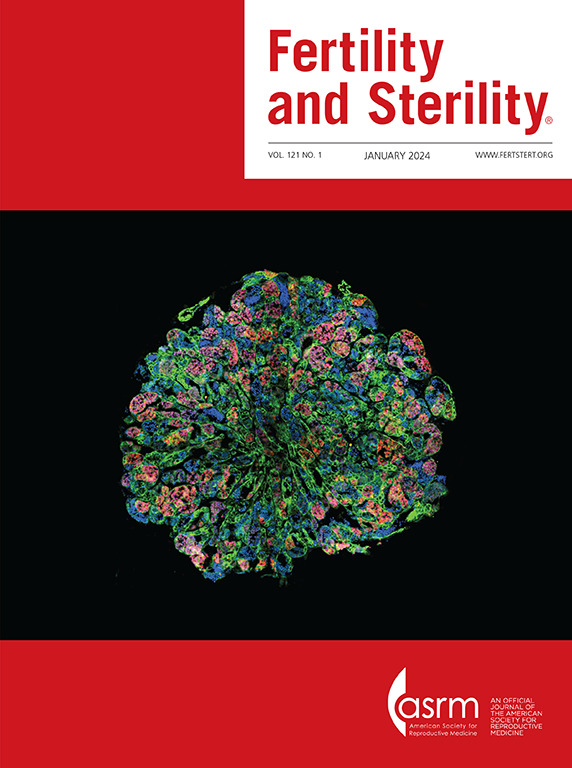Comparative Outcomes of In Vitro Fertilization and Frozen Embryo Transfer Cycles in Non-Major Thalassemia Spectrum and Non-Thalassemia Patients: A Propensity Score-Matched Cohort Study.
IF 7
1区 医学
Q1 OBSTETRICS & GYNECOLOGY
引用次数: 0
Abstract
OBJECTIVE To assess whether oocyte yield, embryo development and pregnancy rates differ between the non-major thalassemia spectrum (NMTS) and non-thalassemia (NT) patients undergoing in vitro fertilization (IVF) or frozen embryo transfer (FET) cycles. DESIGN A propensity score-matched retrospective cohort study. SUBJECTS A total of 41,804 patients who underwent IVF (18,215 cycles) or FET (23,589 cycles) between January 2013 and December 2022 were included in the study. Patients were matched 1:2 for the NT (n = 5,816 IVF, n = 8,004 FET) and NMTS (n = 2,908 IVF, n = 4,002 FET) groups. Within the NMTS group, thalassemia carriers (TC) accounted for 80.7% of IVF cases and 74.9% of FET cases, while non-transfusion-dependent thalassemia (NTDT) patients represented 19.3% and 25.1%, respectively. EXPOSURE Standard ovarian stimulation protocols (GnRH agonist, GnRH antagonist, and minimal stimulation) were used for all patients. Clinical outcomes, including embryo development, clinical pregnancy, live birth, and miscarriage rates, were compared between the groups. MAIN OUTCOME MEASURES IVF cycle outcome (e.g., oocyte retrieval rate, fertilization rate, and blastocyst formation rate) and pregnancy outcomes (e.g., clinical pregnancy rate, live birth rate, and miscarriage rate). RESULTS After matching, the baseline characteristics, including age and body mass index, were comparable between the NT and NMTS groups. No significant differences were observed in oocyte yield and embryo development, including blastocyst formation (NT: 0.54 vs. NMTS: 0.56). In IVF cycles, the clinical pregnancy rate (adjust relative risk [aRR] = 1.03, 95% confidence interval [CI] = 0.96-1.09), live birth rate (aRR = 1.02, 95% CI = 0.95-1.09), and miscarriage rate (aRR = 1.07, 95% CI = 0.92-1.25) were similar. In FET cycles, the clinical pregnancy rate (aRR = 1.01, 95% CI = 0.96-1.07), live birth rate (aRR = 1.03, 95% CI = 0.97-1.10), and miscarriage rate (aRR = 0.92, 95% CI = 0.81-1.04) were comparable. Interaction analysis showed that baseline hormonal levels and ovarian stimulation protocols significantly influenced embryo development but did not affect pregnancy outcomes. CONCLUSION No significant differences in embryo development or pregnancy outcomes were found between NMTS and NT patients undergoing IVF or FET cycles. These findings suggest that NMTS patients do not face additional reproductive challenges in assisted reproductive technology. This study may help reduce reproductive anxiety in NMTS patients and has important public health relevance in resource-limited and high-prevalence regions, where it can support clinical decisions and inform equitable ART care delivery.非重度地中海贫血和非地中海贫血患者体外受精和冷冻胚胎移植周期的比较结果:一项倾向评分匹配的队列研究。
目的评价非重度地中海贫血(NMTS)和非重度地中海贫血(NT)患者在体外受精(IVF)或冷冻胚胎移植(FET)周期中卵母细胞产量、胚胎发育和妊娠率是否存在差异。设计倾向评分匹配的回顾性队列研究。在2013年1月至2022年12月期间,共有41804名接受试管婴儿(18215个周期)或FET(23589个周期)的患者被纳入该研究。NT组(n = 5,816例IVF, n = 8,004例FET)和NMTS组(n = 2,908例IVF, n = 4,002例FET)患者按1:2匹配。在NMTS组中,地中海贫血携带者(TC)占IVF病例的80.7%和FET病例的74.9%,而非输血依赖型地中海贫血(NTDT)患者分别占19.3%和25.1%。所有患者均采用标准卵巢刺激方案(GnRH激动剂、GnRH拮抗剂和最小刺激)。比较两组的临床结果,包括胚胎发育、临床妊娠、活产和流产率。主要观察指标:周期结局(如卵母细胞回收率、受精率、囊胚形成率)和妊娠结局(如临床妊娠率、活产率、流产率)。结果匹配后,NT组和NMTS组的基线特征(包括年龄和体重指数)具有可比性。两组在卵母细胞数量和胚胎发育(包括囊胚形成)方面无显著差异(NT: 0.54 vs. NMTS: 0.56)。在IVF周期中,临床妊娠率(调整相对危险度[aRR] = 1.03, 95%可信区间[CI] = 0.96-1.09)、活产率(aRR = 1.02, 95% CI = 0.95-1.09)、流产率(aRR = 1.07, 95% CI = 0.92-1.25)相似。在FET周期中,临床妊娠率(aRR = 1.01, 95% CI = 0.96-1.07)、活产率(aRR = 1.03, 95% CI = 0.97-1.10)和流产率(aRR = 0.92, 95% CI = 0.81-1.04)具有可比性。相互作用分析表明,基线激素水平和卵巢刺激方案显著影响胚胎发育,但不影响妊娠结局。结论NMTS和NT患者接受IVF或FET周期的胚胎发育和妊娠结局无显著差异。这些发现表明NMTS患者在辅助生殖技术中不会面临额外的生殖挑战。这项研究可能有助于减少NMTS患者的生殖焦虑,并在资源有限和高流行地区具有重要的公共卫生相关性,在那里它可以支持临床决策并为公平的抗逆转录病毒治疗提供信息。
本文章由计算机程序翻译,如有差异,请以英文原文为准。
求助全文
约1分钟内获得全文
求助全文
来源期刊

Fertility and sterility
医学-妇产科学
CiteScore
11.30
自引率
6.00%
发文量
1446
审稿时长
31 days
期刊介绍:
Fertility and Sterility® is an international journal for obstetricians, gynecologists, reproductive endocrinologists, urologists, basic scientists and others who treat and investigate problems of infertility and human reproductive disorders. The journal publishes juried original scientific articles in clinical and laboratory research relevant to reproductive endocrinology, urology, andrology, physiology, immunology, genetics, contraception, and menopause. Fertility and Sterility® encourages and supports meaningful basic and clinical research, and facilitates and promotes excellence in professional education, in the field of reproductive medicine.
 求助内容:
求助内容: 应助结果提醒方式:
应助结果提醒方式:


